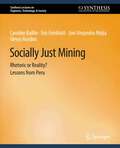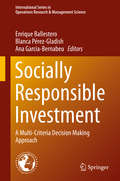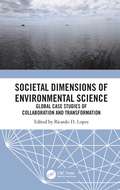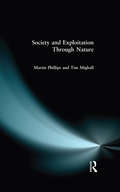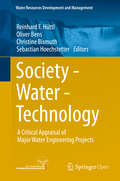- Table View
- List View
Sociality and Normativity for Robots: Philosophical Inquiries into Human-Robot Interactions (Studies in the Philosophy of Sociality #9)
by Raul Hakli Johanna SeibtThis volume offers eleven philosophical investigations into our future relations with social robots--robots that are specially designed to engage and connect with human beings. The contributors present cutting edge research that examines whether, and on which terms, robots can become members of human societies. Can our relations to robots be said to be "social"? Can robots enter into normative relationships with human beings? How will human social relations change when we interact with robots at work and at home? The authors of this volume explore these questions from the perspective of philosophy, cognitive science, psychology, and robotics. The first three chapters offer a taxonomy for the classification of simulated social interactions, investigate whether human social interactions with robots can be genuine, and discuss the significance of social relations for the formation of human individuality. Subsequent chapters clarify whether robots could be said to actually follow social norms, whether they could live up to the social meaning of care in caregiving professions, and how we will need to program robots so that they can negotiate the conventions of human social space and collaborate with humans. Can we perform joint actions with robots, where both sides need to honour commitments, and how will such new commitments and practices change our regional cultures? The authors connect research in social robotics and empirical studies in Human-Robot Interaction to recent debates in social ontology, social cognition, as well as ethics and philosophy of technology. The book is a response to the challenge that social robotics presents for our traditional conceptions of social interaction, which presuppose such essential capacities as consciousness, intentionality, agency, and normative understanding. The authors develop insightful answers along new interdisciplinary pathways in "robophilosophy," a new research area that will help us to shape the "robot revolution," the distinctive technological change of the beginning 21st century.
Socially Enhanced Services Computing: Modern Models and Algorithms for Distributed Systems
by Schahram Dustdar, Daniel Schall, Florian Skopik, Lukasz Juszczyk and Harald PsaierSocially enhanced Services Computing deals with a novel and exciting new field at the intersection between Social Computing, Service-oriented Computing, Crowd Computing, and Cloud Computing. The present work presents a collection of selected papers by the editors of this volume, which they feel will help the reader in understanding this field. The approach discussed allows for a seamless integration of people into trusted dynamic compositions of Human-provided Services and Software-based services, thus empowering new interaction models and processes in massive collaboration scenarios in a Future Internet.
Socially Just Mining: Rethoric or Reality? Lessons from Peru (Synthesis Lectures on Engineers, Technology, & Society)
by Caroline Baillie Eric Feinblatt Joel Alejandro Glevys Rondon Jordan Aitken Rita ArmstrongIn this book we consider ways in which mining companies do and can/should respect the human rights of communities affected by mining operations. We examine what "can and should" means and to whom, in a variety of mostly Peruvian contexts, and how engineers engage in "normative" practices that may interfere with the communities' best interests. We hope to raise awareness of the complexity of issues at stake and begin the necessary process of critique—of self and of the industry in which an engineer chooses to work. This book aims to alert engineering students to the price paid not only by vulnerable communities but also by the natural environment when mining companies engage in irresponsible and, often, illegal mining practices. If mining is to be in our future, and if we are to have a future which is sustainable, engineering students must learn to mine and support mining, in new ways—ways which are fairer, more equitable, and cleaner than today.
Socially Responsible Investment: A Multi-Criteria Decision Making Approach (International Series in Operations Research & Management Science #219)
by Enrique Ballestero Blanca Pérez-Gladish Ana Garcia-BernabeuThis book integrates socially responsible investment into modern portfolio theory from a multi-criteria perspective. Socially responsible investment is a “new deal” championed by the institutional investment and bank sectors, agents that influence mutual funds and other collective investment schemes and which fear that financial strategies without ethical constraints can harm sustainable growth and prosperity. The book shows how to combine financial criteria such as profitability and risk with non-financial criteria such as the protection of the ecosystem, responsible consumption of energy, and healthcare campaigns. The book’s first part presents critical issues in ethical investment, while the second explains in detail the application of goal programming techniques for SRI funds, illustrating their use in actual cases. Part three demonstrates how compromise programming can be applied in the contexts of portfolio selection and risk management. Finally, in its fourth part the book examines the application of other decision-making support methods like the Analytic Hierarchy Process (AHP) framework, the Reference Point Method, and soft computing techniques for portfolio selection.
Societal Adaptation to Climate Variability and Change
by Sally M. KaneChanges in climate and climate variability have an effect on people's behaviour around the world, and public institutions have an important part to play in influencing our ability to respond to and plan for climate risk. We may be able to reduce climate risk by seeking to mitigate the threat on the one hand, and by adapting to a changed climate on the other. Another theme of the book is the integrated role of adaptation and mitigation in framing issues and performing analyses. Adaptation costs fall most heavily on the poor and special attention needs to be paid to adaptation by the poorest populations. An integrating framework is also presented to provide the context for an expansive typology of terms to apply to adaptation. The 12 papers collected here use methods from a variety of disciplines and focus on different time frames for decision making, from short term to the very long term. Readership: Technically trained readers familiar with the policy issues surrounding climate change and interested in learning the scientific underpinnings of issues related to societal adaptation.
Societal Dimensions of Environmental Science: Global Case Studies of Collaboration and Transformation
by Ricardo D. LopezSocietal Dimensions of Environmental Science: Global Case Studies of Collaboration and Transformation, brings together several key examples of the successes and the challenges that exist for environmental stakeholders trying to strike a balance between science and the societal implications of the issues involved. This book provides important methods and approaches necessary for informed decision making and a better understanding of the common threads of learning, collaboration, negotiation, and compromise. It also explains that concepts and skills needed to better understand how specific project goals can be best achieved in the rapidly changing field of environmental management, by providing practical situations and solutions, across a global landscape. This book provides anyone who works in a community setting with the necessary tools and strategies for solving environmental problems and achieving the goals of an environmental project of any type and specifically addresses the topic of how to synthesize community engagement and the environmental science. It describes current environmental issues and lessons learned of what works and what doesn’t work in real situations, and why. It also highlights key examples, which can be used by both management practitioners and research scientists in their specific circumstances. Showcasing a unique compilation of the diverse and specific examples from societies in Asia, Oceania, North America, and the Middle East, with an equally diverse array of authorship, this book serves all policy makers, scientists, organizers, and community members that desire to build better group dynamics for addressing environmental issues.
Societal Dimensions of Environmental Science: Global Case Studies of Collaboration and Transformation
by Ricardo D. LopezSocietal Dimensions of Environmental Science: Global Case Studies of Collaboration and Transformation, brings together several key examples of the successes and the challenges that exist for environmental stakeholders trying to strike a balance between science and the societal implications of the issues involved. This book provides important methods and approaches necessary for informed decision making and a better understanding of the common threads of learning, collaboration, negotiation, and compromise. It also explains that concepts and skills needed to better understand how specific project goals can be best achieved in the rapidly changing field of environmental management, by providing practical situations and solutions, across a global landscape. This book provides anyone who works in a community setting with the necessary tools and strategies for solving environmental problems and achieving the goals of an environmental project of any type and specifically addresses the topic of how to synthesize community engagement and the environmental science. It describes current environmental issues and lessons learned of what works and what doesn’t work in real situations, and why. It also highlights key examples, which can be used by both management practitioners and research scientists in their specific circumstances. Showcasing a unique compilation of the diverse and specific examples from societies in Asia, Oceania, North America, and the Middle East, with an equally diverse array of authorship, this book serves all policy makers, scientists, organizers, and community members that desire to build better group dynamics for addressing environmental issues.
Societal Responsibility of Artificial Intelligence: Towards an Ethical and Eco-responsible AI
by Jerome BerangerThe digital world is characterized by its immediacy, its density of information and its omnipresence, in contrast to the concrete world. Significant changes will occur in our society as AI becomes integrated into many aspects of our lives. This book focuses on this vision of universalization by dealing with the development and framework of AI applicable to all. It develops a moral framework based on a neo-Darwinian approach - the concept of Ethics by Evolution - to accompany AI by observing a certain number of requirements, recommendations and rules at each stage of design, implementation and use. The societal responsibility of artificial intelligence is an essential step towards ethical, eco-responsible and trustworthy AI, aiming to protect and serve people and the common good in a beneficial way.
Societal Responsibility of Artificial Intelligence: Towards an Ethical and Eco-responsible AI
by Jérôme BérangerThe digital world is characterized by its immediacy, its density of information and its omnipresence, in contrast to the concrete world. Significant changes will occur in our society as AI becomes integrated into many aspects of our lives. This book focuses on this vision of universalization by dealing with the development and framework of AI applicable to all. It develops a moral framework based on a neo-Darwinian approach - the concept of Ethics by Evolution - to accompany AI by observing a certain number of requirements, recommendations and rules at each stage of design, implementation and use. The societal responsibility of artificial intelligence is an essential step towards ethical, eco-responsible and trustworthy AI, aiming to protect and serve people and the common good in a beneficial way.
Societal Risk Assessment: How Safe is Safe Enough? (General Motors Research Laboratories Symposia Ser.)
by Richard C. Schwing Walter A. AlbersThis volume constitutes the papers and discussions from a symposium on "Societal Risk Assessment: How Safe is Safe Enough?" held at the General Motors Research Laboratories on October 8-9, 1979. This symposium was the twenty-fourth in an annual series sponsored by the Research Laboratories. Initi ated in 1957, these symposia have as their objective the promotion of the interchange ofknowledge among specialists from many allied disciplines in rapidly developing or changing areas ofscience or technology. Attendees characteristically represent the academic, government, and industrial institutions that are noted for their ongoing activities in the particular area of interest. The objective of this symposium was to develop a balanced view of the current status of societal risk assessment's role in the public policy process and then to establish, if possible, future directions of research. Accordingly, the symposium was structured in two dimensions; certainty versus uncertainty and the subjective versus the objective. Furthermore, people representing extremely diverse discip lines concerned with the perception, quantification, and abatement of risks were brought together to provide an environment that stimulated the exchange of ideas and experiences. The keys to this exchange were the invited papers, arranged into four symposium sessions. These papers appear in this volume in the order of their presentation. The discussions that in turn followed from the papers are also included.
Society 5.0: Cyber-Solutions for Human-Centric Technologies (Studies in Systems, Decision and Control #437)
by Alla G. Kravets Alexander A. Bolshakov Maxim V. ShcherbakovThis book focuses on open issues of Society 5.0, a new paradigm of a society, that balances a human-centred approach and technologies based on cyber-physical systems and artificial intelligence. The book contains results of how intelligent or cyber-solutions help to improve the quality of life in society despite new challenges. This book includes five sections. Section Society 5.0: Biomedicine and Healthcare present how cyber-physical systems help in healthcare, e.g. analysis of clinical data in pregnant women with hypertension, breast cancer diagnostics, healthy diet design and others. In the chapter, the problem of data analysis and optimization is considered. The second Section, Society 5.0: Human-centric Cyber-Solutions highlight new findings on constructing virtual reality simulators, training of workers on the basis of equipment's digital twins, development of human capital. Society 5.0: Socio-Economic Systems Modelling includes chapters concerning the application of quantum-like mathematical models for the analysis of socio-economic systems, indicative planning models for agriculture, approaches of assessing and monitoring competitiveness risks of regions. A section, Society 5.0: Industrial Cyber-Solutions provides new results on cyber-physical systems of Russian oil market, railway joint diagnostics, and information support for maintenance and repair of a machine-building cyber-physical system. The last section, Society 5.0: Cyber-Solutions Security consider interoperability issues of security, the video conferencing, and scaling networks.This book is directed to researchers, practitioners, engineers, software developers, professors and students. We do hope the book will be useful for them.
Society 5.0: Industry of the Future, Technologies, Methods and Tools
by Bruno SalguesFollowing the rapid development of connected technologies, which are now highly sophisticated and spread across the globe, Society 5.0 has emerged and brought with it a dramatic societal shift. In 1998, Kodak, the world leader in photographic film, had 170,000 employees. It thus seemed unthinkable that just 3 years later, the majority of people would stop taking photographs to paper film and that Kodak would have disappeared. These are the stakes of this new society that is taking shape. This book, which does not seek to critique current politics, management or marketing literature, aims to fight against the excesses of this often-misunderstood Society 5.0 and to present the ideas and associated technologies that comprise it, all working towards societal improvement. Among these technologies, artificial intelligence, robotics, digital platforms and 3D printing are undoubtedly the most important, and thus receive the greatest focus.
Society 5.0: Industry of the Future, Technologies, Methods and Tools
by Bruno SalguesFollowing the rapid development of connected technologies, which are now highly sophisticated and spread across the globe, Society 5.0 has emerged and brought with it a dramatic societal shift. In 1998, Kodak, the world leader in photographic film, had 170,000 employees. It thus seemed unthinkable that just 3 years later, the majority of people would stop taking photographs to paper film and that Kodak would have disappeared. These are the stakes of this new society that is taking shape. This book, which does not seek to critique current politics, management or marketing literature, aims to fight against the excesses of this often-misunderstood Society 5.0 and to present the ideas and associated technologies that comprise it, all working towards societal improvement. Among these technologies, artificial intelligence, robotics, digital platforms and 3D printing are undoubtedly the most important, and thus receive the greatest focus.
Society 5.0 and the Future of Emerging Computational Technologies: Practical Solutions, Examples, and Case Studies (Demystifying Technologies for Computational Excellence)
by Neeraj Mohan Surbhi Gupta Chuan-Ming LiuThis book discusses the technological aspects for the implementation of Society 5.0. The foundation and recent advances of emerging technologies such as artificial intelligence, data science, Internet of Things, and Big Data for the realization of Society 5.0 are covered. Practical solutions to existing problems, examples, and case studies are also offered. Society 5.0 and the Future of Emerging Computational Technologies: Practical Solutions, Examples, and Case Studies discusses technologies such as machine learning, artificial intelligence, and Internet of Things for the implementation of Society 5.0. It offers a firm foundation and understanding of the recent advancements in various domains such as data analytics, neural networks, computer vision, and robotics, along with practical solutions to existing problems in fields such as healthcare, manufacturing industries, security, and infrastructure management. Applications and implementations are highlighted along with the correlation between technologies. Examples and case studies are presented throughout the book to augment text. This book can be used by research scholars in the engineering domain who wish to gain knowledge and contribute towards a modern and secure future society. The book will also be useful as a reference at universities for postgraduate students who are interested in technological advancements.
Society 5.0 and the Future of Emerging Computational Technologies: Practical Solutions, Examples, and Case Studies (Demystifying Technologies for Computational Excellence)
by Neeraj Mohan Surbhi Gupta Chuan-Ming LiuThis book discusses the technological aspects for the implementation of Society 5.0. The foundation and recent advances of emerging technologies such as artificial intelligence, data science, Internet of Things, and Big Data for the realization of Society 5.0 are covered. Practical solutions to existing problems, examples, and case studies are also offered. Society 5.0 and the Future of Emerging Computational Technologies: Practical Solutions, Examples, and Case Studies discusses technologies such as machine learning, artificial intelligence, and Internet of Things for the implementation of Society 5.0. It offers a firm foundation and understanding of the recent advancements in various domains such as data analytics, neural networks, computer vision, and robotics, along with practical solutions to existing problems in fields such as healthcare, manufacturing industries, security, and infrastructure management. Applications and implementations are highlighted along with the correlation between technologies. Examples and case studies are presented throughout the book to augment text. This book can be used by research scholars in the engineering domain who wish to gain knowledge and contribute towards a modern and secure future society. The book will also be useful as a reference at universities for postgraduate students who are interested in technological advancements.
Society 5.0: Cyberspace for Advanced Human-Centered Society (Studies in Systems, Decision and Control #333)
by Alla G. Kravets Alexander A. Bolshakov Maxim ShcherbakovThis book includes new findings on socio-economic cyber systems control and development approaches based on AI and data-driven techniques. The authors determine key social challenges and the main features of management and modeling processes. To enhance the efficiency of the socio-economic process, new approaches were suggested as well as its components based on the concept of Society 5.0. In this book, the authors substantiate the scientific, practical, and methodological approaches to the smart technologies’ development. The core is a human-centered concept of cyber systems as well as the intelligent paradigm. Approaches combined both mathematical models and data processing techniques are also proposed as advanced methods for smart system design for ecology and health care. The implementations of the developed prototypes, including testing in real domains, which have collected and analyzed big data and proved their effectiveness, are presented. The target audience of the book are practitioners, enterprise representatives, scientists, and Ph.D. and Master students who perform scientific research or applications of socio-economic cyber systems in different domains.
Society 5.0: Human-Centered Society Challenges and Solutions (Studies in Systems, Decision and Control #416)
by Alla G. Kravets Alexander A. Bolshakov Maxim ShcherbakovThis book focuses on open issues of Society 5.0, a new paradigm of a society that balances a human-centred approach and technologies based on cyber-physical systems and artificial intelligence. The book contains results of how intelligent or cyber-physical systems help to improve the quality of life in society despite new challenges. Discusses implemented breakthrough systems, models, programs, and methods that cover the following topics: biomedicine and healthcare, innovations in socio-economic systems, intelligent energetics, advances in transport systems, human-centric technologies. These approaches help to improve human society using cyber-physical systems in a dramatically changing environment. The target audience of the book are practitioners, enterprises representatives, scientists, PhD and Master students who perform scientific research on the application of cyber-physical systems towards Society 5.0.
Society 5.0: Smart Future Towards Enhancing the Quality of Society (Advances in Sustainability Science and Technology)
by K. G. Srinivasa G. M. Siddesh S. R. ManisekharThe book discusses Society 5.0 which fills the gap between cyber and physical space by providing a balanced environment between economic and social needs. The book is divided into two parts; part A focuses on various concepts related to Society 5.0 such as cyber space, physical space, information management and digital transformation. Part B discusses various integrated fields in Society 5.0, such as super-smart healthcare system, super-smart hospitality system, smart building, and transport management system. It also illustrates the concepts of big data, real-time analytics for smart Society 5.0 with an insight of real-time case studies.
Society and Exploitation Through Nature
by Martin Phillips Tim MighallSociety and Exploitation Through Nature offers an integrated approach to the environment, linking the philosophical, social and physical sciences to environmental problems and issues. The text covers three main themes; exploitation of nature and society; the limits of exploitation through sustainability and managing environmental problems. These themes are illustrated throughout the book with global case studies.
Society and Exploitation Through Nature
by Martin Phillips Tim MighallSociety and Exploitation Through Nature offers an integrated approach to the environment, linking the philosophical, social and physical sciences to environmental problems and issues. The text covers three main themes; exploitation of nature and society; the limits of exploitation through sustainability and managing environmental problems. These themes are illustrated throughout the book with global case studies.
Society Conference on Energy Management (Ceramic Engineering and Science Proceedings #12)
by William J. SmothersThis volume is part of the Ceramic Engineering and Science Proceeding (CESP) series. This series contains a collection of papers dealing with issues in both traditional ceramics (i.e., glass, whitewares, refractories, and porcelain enamel) and advanced ceramics. Topics covered in the area of advanced ceramic include bioceramics, nanomaterials, composites, solid oxide fuel cells, mechanical properties and structural design, advanced ceramic coatings, ceramic armor, porous ceramics, and more.
Society - Water - Technology: A Critical Appraisal of Major Water Engineering Projects (Water Resources Development and Management)
by Reinhard F. Hüttl Oliver Bens Christine Bismuth Sebastian HoechstetterThis book presents the results of the Interdisciplinary Research Group "Society – Water – Technology" of the Berlin-Brandenburg Academy of Sciences and Humanities. It describes interdisciplinary evaluation criteria for major water engineering projects (MWEPs) and portrays an application to the Lower Jordan Valley (Middle East) and the Fergana Valley (Central Asia). Both areas are characterised by transboundary conflicts, by challenges due to demographic and climate change and by political and societal pressures. Based on the findings, the book provides recommendations for science and political decisions makers as well as for international financing institutions. In addition, it outlines research gaps from an interdisciplinary perspective.In the past, MWEPs have been used as an instrument to cope with the demands of growing populations and to enhance development progress. Experiences with MWEPs have shown that a purely technical approach has not always brought about the desired results. In many cases, MWEPs have even resulted in negative implications for society and environment. Therefore, improved management strategies and enhanced technologies for a sustainable water resource management system are a prerequisite to meet present and future challenges. And, moreover, the continuous evaluation and optimisation of these measures is, likewise, a must.
A Socio-cultural Perspective on Patient Safety
by Justin WaringThis edited volume of original chapters brings together researchers from around the world who are exploring the facets of health care organization and delivery that are sometimes marginal to mainstream patient safety theories and methodologies but offer important insights into the socio-cultural and organizational context of patient safety. By examining these critical insights or perspectives and drawing upon theories and methodologies often neglected by mainstream safety researchers, this collection shows we can learn more about not only the barriers and drivers to implementing patient safety programmes, but also about the more fundamental issues that shape notions of safety, alternate strategies for enhancing safety, and the wider implications of the safety agenda on the future of health care delivery. In so doing, A Socio-cultural Perspective on Patient Safety challenges the taken-for-granted assumptions around fundamental philosophical and political issues upon which mainstream orthodoxy relies. The book draws upon a range of theoretical and empirical approaches from across the social sciences to investigate and question the patient safety movement. Each chapter takes as its focus and question a particular aspect of the patient safety reforms, from its policy context and theoretical foundations to its practical application and manifestation in clinical practice, whilst also considering the wider implications for the organization and delivery of health care services. Accordingly, the chapters each draw upon a distinct theoretical or methodological approach to critically explore specific dimensions of the patient safety agenda. Taken as a whole, the collection advances a strong, coherent argument that is much needed to counter some of the uncritical assumptions that need to be described and analyzed if patient safety is indeed to be achieved.
A Socio-cultural Perspective on Patient Safety
by Justin WaringThis edited volume of original chapters brings together researchers from around the world who are exploring the facets of health care organization and delivery that are sometimes marginal to mainstream patient safety theories and methodologies but offer important insights into the socio-cultural and organizational context of patient safety. By examining these critical insights or perspectives and drawing upon theories and methodologies often neglected by mainstream safety researchers, this collection shows we can learn more about not only the barriers and drivers to implementing patient safety programmes, but also about the more fundamental issues that shape notions of safety, alternate strategies for enhancing safety, and the wider implications of the safety agenda on the future of health care delivery. In so doing, A Socio-cultural Perspective on Patient Safety challenges the taken-for-granted assumptions around fundamental philosophical and political issues upon which mainstream orthodoxy relies. The book draws upon a range of theoretical and empirical approaches from across the social sciences to investigate and question the patient safety movement. Each chapter takes as its focus and question a particular aspect of the patient safety reforms, from its policy context and theoretical foundations to its practical application and manifestation in clinical practice, whilst also considering the wider implications for the organization and delivery of health care services. Accordingly, the chapters each draw upon a distinct theoretical or methodological approach to critically explore specific dimensions of the patient safety agenda. Taken as a whole, the collection advances a strong, coherent argument that is much needed to counter some of the uncritical assumptions that need to be described and analyzed if patient safety is indeed to be achieved.
Socio-Economic Analysis of Arsenic Contamination of Groundwater in West Bengal (India Studies in Business and Economics)
by Abhijit Das Joyashree Roy Sayantan ChakrabartiThis book presents a socio-economic analysis of the issues linking technological innovation in providing arsenic-safe drinking water in rural areas. It presents concrete field based experiences of experiments and case studies depicting the plight and sufferings of people due to failed technological deployment strategies over the past two decades in West Bengal, the most arsenic-exposed state in India and also the first to act for remediation of the crisis. One of the greatest challenges in arsenic-exposed zones is to provide sustainable access to reliably arsenic-safe free water. For nearly twenty years the Government of India and national water distribution institutions in collaboration with multi-lateral funding agencies have sought to pump in money, push technology collected through global tenders, and enlist the support of non-governmental organizations (NGOs), but their efforts have yielded little success. This book is the outcome of the authors’ intensive fieldwork, guided by the conceptual framework of the latest literature on environmental economics and consumer behaviour. It presents a framework and estimates based on field level primary data. Secondary official source-based data are also collated from various scattered sources into a valuable, comprehensive collection. Lastly, the book includes a revealing analysis of factors affecting households’ participation.


